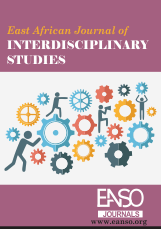The Impact of Small Livestock Project Intervention on Household Welfare in Rwanda. A Case Study of the Prism Project in Burera District
Abstract
Livestock remains a cornerstone of rural livelihoods worldwide, contributing significantly to food security, economic growth, and poverty reduction. Globally, over 1.3 billion people rely on livestock, which contributes around 40% to agricultural GDP (FAO, 2018). In developing economies, livestock development is a critical pathway for improving rural well-being. In East Africa, livestock supports rural development by providing employment, export income, and nutrition (Thornton, Herrero, & Ericksen, 2020). For example, Kenya’s East Africa Dairy Development (EADD) project increased milk production by 80% through private-sector partnerships and milk collection hubs. In Rwanda, where 72% of the population depends on agriculture, small livestock programs like Girinka have enhanced rural livelihoods by increasing milk production and household income. Despite its importance, the sector faces significant global challenges, including climate change, zoonotic diseases, and market instability. Uganda experienced a 60% livestock mortality rate in 2021, with 40% of poultry losses due to Newcastle disease. Rwanda faces 30% post-harvest losses due to market barriers, and Somalia’s pastoralists have lost up to 60% of their herds during droughts. Rural areas in Rwanda, including Burera District, continue to experience malnutrition, poverty, and limited market access. To address these gaps, the PRISM project was introduced to distribute livestock, improve markets, provide training, and empower farmers through self-help groups (Heifer International, 2023). However, the project’s localized impact had not been fully assessed. This study evaluated PRISM’s effectiveness in Burera District using a mixed-methods approach. Quantitative data from 314 beneficiaries were analyzed with SPSS, while qualitative insights came from focus groups and interviews. Results showed a strong uptake of core interventions: livestock distribution (86.6%), training (92.9%), income diversification (92%), and access to animal-source foods (99.4%). Yet, challenges remained in gender equity training (40.8%), veterinary services (59.6%), and market linkage (19.4%). The findings underscore the need for integrated policies that combine grassroots empowerment with private-sector partnerships and subsidized services. This study informs Rwanda’s agricultural policies and offers scalable lessons for similar contexts in Africa.
Downloads
References
Creswell, J. W., & Creswell, J. D. (2018). Research design: Qualitative, quantitative, and mixed methods approach (5th ed.). Sage Publications.
Dalsgaard, P., Smith, J., & O'Brien, T. (2015). The role of participatory approaches in sustainable community development: Evidence from Heifer International. Community Development Journal, 50(4), 623– 638. https://doi.org/10.1093/cdj/bsv015
Ellis, F. (2000). Rural livelihoods and diversity in developing countries. Oxford University Press. https://doi.org/10.1093/oso/9780198296959.001.0001
Herry, A., & Muzira, T. (2009). Enhancing market systems for smallholder farmers: Lessons from East Africa. Journal of Agricultural Economics, 60(2), 312– 329. https://doi.org/10.1111/j.1477-9552.2009.00212.x
International Fund for Agricultural Development. (2023). Rwanda: Partnership for Resilient and Inclusive Small Livestock Markets (PRISM). https://www.ifad.org/en/web/operations/-/project/2000001871
Kiptot, E., & Franzel, S. (2019). Smallholder participation in livestock markets in East Africa: Opportunities and challenges. Agricultural Systems, 174, 124– 135. https://doi.org/10.1016/j.agsy.2019.04.008
Leach, M., & Sitaram, S. (2021). Empowerment through value-based community development approaches: Insights from rural India. Development in Practice, 31(5), 512–527. https://doi.org/10.1080/09614524.2021.1911943
Rwanda Agriculture and Animal Resources Development Board (RAB). (2022). Annual Report on Livestock Sector Performance. http://www.rab.gov.rw/publications
United Nations Development Programme. (2020). Sustainable Development Goals Report: Rwanda. https://www.undp.org/rwanda/publications
World Bank. 2020). Rwandapovertyassessment. https://documents.worldbank.org/en/publication/documents- reports/documentdetail/157631589468347561/rwanda-poverty-assessment
Ellis, F. (1998). Household strategies and rural livelihood diversification. Journal of Development Studies, 35(1), 1- 38. https://doi.org/10.1080/00220389808422553
Schultz, T. W. (1961). Investment in human capital. American Economic Review, 51(1), 17. https://www.jstor.org/stable/1818907
Copyright (c) 2025 Samuel Nsengimana, Denys Uwimpuhwe, PhD

This work is licensed under a Creative Commons Attribution 4.0 International License.




























